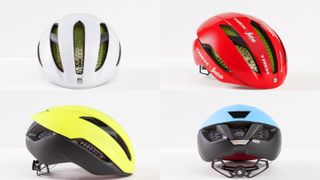Trek and Bontrager announce 'most advanced helmet technology ever designed'
WaveCel design 48x more effective at reducing concussions than traditional EPS foam










Trek and Bontrager have launched a revolutionary new helmet design – WaveCel – that has been released with four new helmets from the US brand.
WaveCel replaces traditional EPS foam with layers of cells designed to move independently until the cell walls crumple and glide, dissipating both direct and rotational energy away from your head.
Tested independently at the Helmet Impact Testing (HIT) facility of the Portland Biomechanics Laboratory, results showed Bontrager WaveCel helmets prevent concussion in 98.8 per cent of crash tests at a 45-degree angle, potentially changing future helmet design entirely.
Construction of the WaveCel helmets retains some EPS foam, although the volume is reduced versus traditional designs. The flexible WaveCel construction then lines the inside of the helmet to disperse impact and rotational energy while also offering a comfortable fit that flexes to individual head shapes.
Bontrager has launched four helmet models integrating the technology: the XXX WaveCel Road Helmet, the Blaze WaveCel MTB Helmet, the Specter WaveCel Road Helmet and the Charge WaveCel Commuter helmet. Both the XXX WaveCel and Specter WaveCel models will be used by the Trek-Segafredo men's and women's teams for training and racing this season.
In a press release, Trek President John Burke said: "Trek is committed to making riding safer and more accessible for everyone. WaveCel is the most advanced helmet technology ever designed, and these helmets are a big step toward making riding a safer, more enjoyable experience for everyone."

Bontrager and Trek say the WaveCel helmet liner adds around 53 grams of additional weight to the helmet – a marginal cost for the safety gains made.
Get The Leadout Newsletter
The latest race content, interviews, features, reviews and expert buying guides, direct to your inbox!
The technology is exclusive to Bontrager for cycling applications. However, a spokesman for Bontrager explained to Cyclingnews that WaveCel has an array of potential applications for other sports outside of cycling.
The testing
Trek and Bontrager say helmet designs have remained largely unchanged for 30 years. However, the introduction of MIPS liners in recent years, which has been implemented by an array of helmet brands, has made some strides in reducing the effects of rotational impact when crashing.
The HIT study at the Portland Biomechanics Laboratory took MIPS technology into account in the testing with 60 Scott ARX helmets used. Twenty of the helmets retained traditional EPS foam, twenty helmets were fitted with a MIPS slip liner and the final twenty helmets were modified with WaveCel technology.
Five helmets from each design option were then subjected to oblique impacts onto an angled anvil at 30-degrees (4.8m/s), 45-degrees (4.8m/s), 45-degrees (6.2m/s) and 60-degrees (4.8m/s).
Focusing specifically on the percentage risk of an Abbreviated Injury Scale (AIS) level 2 Traumatic Brain Injury (TBI), WaveCel technology reduces the risk in all tested scenarios.
Brain Injury Risk (%)
| Oblique impact angle and speed | EPS | MIPS | WaveCel |
| 30-degrees (4.8m/s) | 43% | 29% | 8% |
| 45-degrees (4.8m/s) | 44% | 14% | 1.20% |
| 45-degrees (6.2m/s) | 59.20% | 34.20% | 1.20% |
| 60-degrees (4.8m/s) | 6.40% | 0.60% | 0.20% |
Real-world scenarios will be very different from controlled crash simulation, but the study does claim that the majority of real-world oblique impacts of helmeted bicyclists occur at impact angles of 30-60 degrees.
Each of the four new Bontrager WaveCel helmets received top-scoring five-star rankings in Virginia Tech's helmet safety tests, which has been testing and rating helmets across industries to determine the products that will best reduce head injury risk for nearly a decade in association with the Insurance Institute for Highway Safety.
Bontrager WaveCel helmet range
Safety and injury prevention is clearly the big story of the WaveCel range, but Bontrager know that aesthetic, performance and fit are all key aspects that also need to be considered.
Bontrager say all of their WaveCel helmets have also been extensively tested in the wind tunnel for air-flow performance and a Boa ratchet dial to the rear of the helmet offers a secure and customisable fit.

Bontrager XXX WaveCel
The WaveCel structure inside the helmet is designed to crumple and glide under impact and so following an impact – as with traditional helmets – the helmet is no longer safe to use.
Bontrager offers a one-year crash replacement programme for all four of the new helmets, and also offers a 30-day return guarantee for those who don't like, or change their mind about, the helmet after purchase.
| Model | Price | Claimed Weight (size M) |
| Bontrager XXX WaveCel Road Helmet | $299.99 | 352g |
| Bontrager Blaze WaveCel MTB Helmet | $299.99 | 420g |
| Bontrager Specter WaveCel Road Helmet | $149.99 | 341g |
| Bontrager Charge WaveCel Commuter Helmet | $149.99 | 428g |
(International pricing not yet available)
Bontrager's WaveCel material at first glance appears to use similar technology to Smith Optics' Aerocore or honeycomb-type technology. Bontrager says that while this technology is designed to prevent impacts, these impacts are more focused on skull fractures and do not fully address the rotational forces more commonly experienced in cycling accidents.
The ability for WaveCel to flex around the head on the inside of the helmet also offers comfort aspects and greater ventilation than standard EPS helmets.
Bontrager WaveCel helmets are available through authorised Trek and Bontrager retailers. Learn more about WaveCel here.
Most Popular

